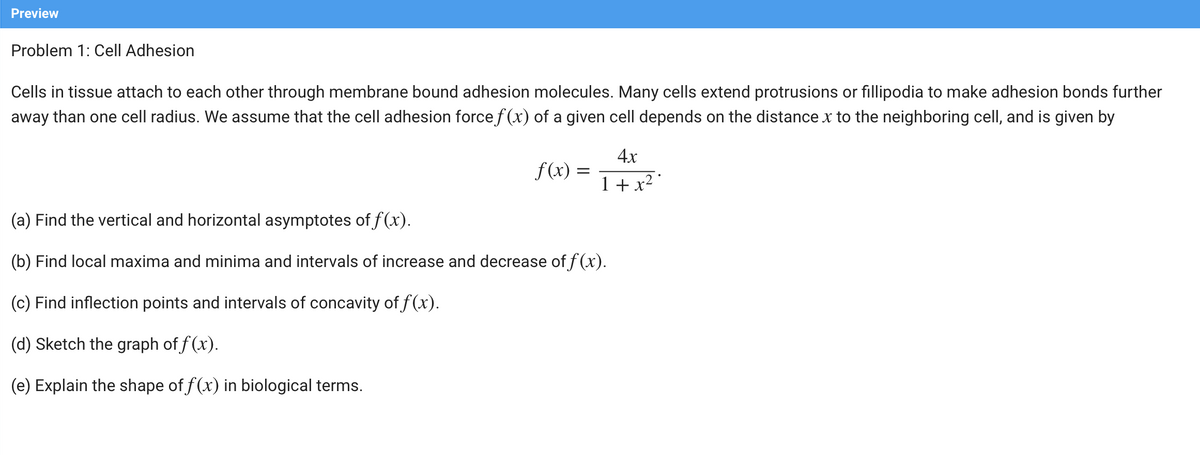Cells in tissue attach to each other through membrane bound adhesion molecules. Many cells extend protrusions or fillipodia to make adhesion bonds further away than one cell radius. We assume that the cell adhesion force f (x) of a given cell depends on the distance x to the neighboring cell, and is given by 4x f(x) = 1+ x² ° (a) Find the vertical and horizontal asymptotes of f (x). (b) Find local maxima and minima and intervals of increase and decrease of f(x). (c) Find inflection points and intervals of concavity of f (x).
Cells in tissue attach to each other through membrane bound adhesion molecules. Many cells extend protrusions or fillipodia to make adhesion bonds further away than one cell radius. We assume that the cell adhesion force f (x) of a given cell depends on the distance x to the neighboring cell, and is given by 4x f(x) = 1+ x² ° (a) Find the vertical and horizontal asymptotes of f (x). (b) Find local maxima and minima and intervals of increase and decrease of f(x). (c) Find inflection points and intervals of concavity of f (x).
Functions and Change: A Modeling Approach to College Algebra (MindTap Course List)
6th Edition
ISBN:9781337111348
Author:Bruce Crauder, Benny Evans, Alan Noell
Publisher:Bruce Crauder, Benny Evans, Alan Noell
Chapter5: A Survey Of Other Common Functions
Section5.2: Power Functions
Problem 17E: Tsunami Waves and BreakwatersThis is a continuation of Exercise 16. Breakwaters affect wave height...
Related questions
Question

Transcribed Image Text:Preview
Problem 1: Cell Adhesion
Cells in tissue attach to each other through membrane bound adhesion molecules. Many cells extend protrusions or fillipodia to make adhesion bonds further
away than one cell radius. We assume that the cell adhesion force f (x) of a given cell depends on the distance x to the neighboring cell, and is given by
4x
f(x) =
1 + x² °
(a) Find the vertical and horizontal asymptotes of f(x).
(b) Find local maxima and minima and intervals of increase and decrease of f (x).
(c) Find inflection points and intervals of concavity of f (x).
(d) Sketch the graph of f (x).
(e) Explain the shape of f(x) in biological terms.
Expert Solution
This question has been solved!
Explore an expertly crafted, step-by-step solution for a thorough understanding of key concepts.
This is a popular solution!
Trending now
This is a popular solution!
Step by step
Solved in 2 steps with 2 images

Recommended textbooks for you

Functions and Change: A Modeling Approach to Coll…
Algebra
ISBN:
9781337111348
Author:
Bruce Crauder, Benny Evans, Alan Noell
Publisher:
Cengage Learning

Algebra & Trigonometry with Analytic Geometry
Algebra
ISBN:
9781133382119
Author:
Swokowski
Publisher:
Cengage

Functions and Change: A Modeling Approach to Coll…
Algebra
ISBN:
9781337111348
Author:
Bruce Crauder, Benny Evans, Alan Noell
Publisher:
Cengage Learning

Algebra & Trigonometry with Analytic Geometry
Algebra
ISBN:
9781133382119
Author:
Swokowski
Publisher:
Cengage